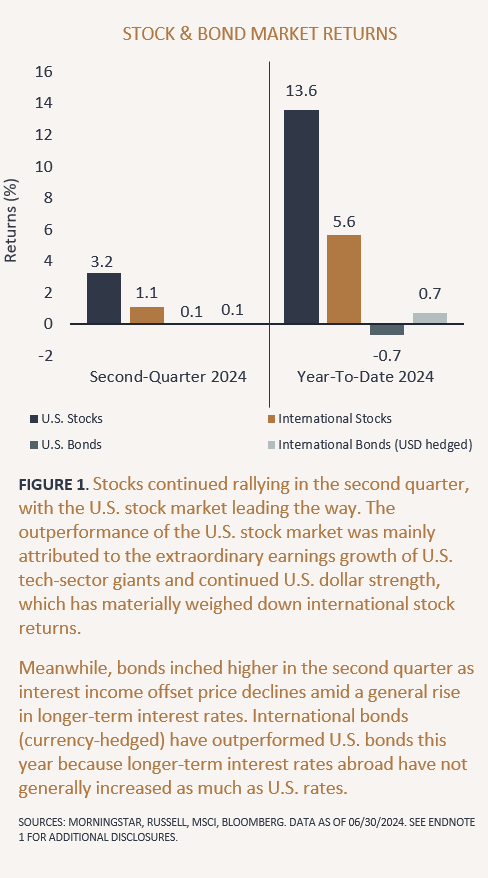The Engine Behind the Rally
In mid‑July 2025, stock markets reached new heights as investor optimism surged alongside advances in artificial intelligence. The S&P 500, Nasdaq Composite, and Dow Jones all pushed into record territory—even amid macroeconomic jitters and tariff headlines. Underpinning this rally is a singular force: AI‑driven technology in large‑cap firms.
Leading the charge is Nvidia, which recently became the first public company ever to reach a $4 trillion market capitalization—symbolizing the scale and centrality of AI in today’s markets. Its share price is up over 280% in two years, including 18% in 2025 alone, and its forward price‑earnings ratio sits around 32×, indicating robust earnings growth rather than frothy speculation
1. Market Drivers Behind the AI-Fueled Surge
Tech Sector Dominance
Technology and communication services now make up over 45% of the S&P 500—an all‑time high, underscoring how much equity inflows depend on AI‑centric companies
Major players—Microsoft, Meta, Alphabet, Amazon, and Nvidia—are not only dominating market cap but setting earnings expectations. These firms are investing heavily in AI infrastructure, including data centers and AI model deployment. BlackRock’s analysis suggests AI will remain the primary growth engine for markets over the next 12 to 18 months.
Earnings Beat the Street
After 78% of Q1 companies topped expectations, analysts expect Q2 surprises as well—particularly among tech firms investing in AI. Investor confidence is anchored on expectations for continued earnings strength, even amid tariff and inflation uncertainty
Macro Tailwinds: Rate Cuts Potential
Market participants see the Federal Reserve leaning toward rate cuts later in 2025. A more dovish stance could enhance equity valuations, especially for AI firms with high earnings potential and strong cash flows.
2. Neo-Dot-Com? Historical Parallels—and Divergence
Nasdaq Overdrive & Bubble Comparisons
Some market watchers draw historic comparisons between the current AI rally and the late 1990s dot‑com bubble. But experts stress important differences:
- Today’s tech firms boast substantial profits, cash flow, and real earnings.
- Valuation multiples, though high, remain below historical bubble peaks.
- Tech is supported by real infrastructure demand rather than speculative narratives
Barron’s notes that unlike the bear market that hit Cisco in 2000, today’s dominant AI companies have real earnings momentum—suggesting the current trend may be sustainable through late 2025 and beyond
3. Stocks in Focus: Leaders and Sector Themes
Nvidia: The AI Crown Jewel
Nvidia’s meteoric rise reflects its dominance in GPUs and data center infrastructure:
- Q2 data center revenue soared 154% year-over-year, bolstered by demand for its Blackwell and Hopper chip architectures
- Market analysts, including Citi, raised price targets nominally to $190, projecting massive expansion in sovereign AI dollars and chip sales—even amid possible trade restrictions
Goldman, while broadly bullish, warns of supply chain headwinds and calls for continued innovation in monetizing infrastructure investments—such as Omniverse and generative models
Beyond Nvidia: A Broadening Field
Other names powering investor appetite include:
- AMD: Riding technical breakout patterns and soaring data center sales, with targets near $250 by year‑end
- Enterprise AI firms like Palantir, Snowflake, Salesforce continue to attract interest for narrow, high-margin recurring revenues
- Software leaders and cloud hyperscalers such as Microsoft and Meta are investing billions in AI adoption—supporting broader market strides
4. Structural and Behavioral Reinforcements
Retail Participation & Fearless Trading
Retail traders remain a potent force, churning out record inflows into equities and ETFs in 2025—especially during dip opportunities. That demand continues to support cyclical strength in indices, particularly the Nasdaq 100
The “TACO Trade”: Dismissing Tariff Threats
Even as President Trump renews tariff threats—on copper, Japan, South Korea, and others—investors have leaned on the so-called TACO trade belief: that most stringent tariffs get delayed or rolled back before implementation. Markets have shown muted responses, reinforcing confidence in policy reversals.
5. Risks and Warning Flags
Concentration Concerns
Industry analysts warn the market’s narrow focus leaves it vulnerable:
- Only about half of S&P 500 stocks currently trade above their 200‑day moving averages—a worrying sign for long‑term breadth.
- Tech represents a disproportionate share of valuations relative to its weight in the real economy.
Valuations and Cyclical Vulnerability
- The S&P 500 trades at 24.5× forward earnings, while the Nasdaq trades over 30×. Heightened sentiment and narrow leadership may leave markets exposed to sentiment reversals on modest earnings disappointments or macro surprises.
- Analysts caution that historical patterns—like Cisco in 2000—serve as reminders: rapid rises can reverse, particularly when growth expectations overshoot fundamentals
Macro and Policy Shocks
- Tariff flare-ups may induce inflation or pressure supply chains, pressuring margins and delaying consumer adoption of AI innovations.
- Should inflation re-accelerate or the Fed remain reluctant to ease, equity momentum may falter—especially in richly valued tech sectors.
6. Analyst Views: Bullish with an Eye on Caution
Sanctuary Wealth & Mary Ann Bartels
Bartels forecasts 12% further upside for the S&P 500 by year-end—targeting 7,000—driven by AI innovation and potential rate cuts. Despite cautious sentiment, she sees structural positives outweighing short‑term headwinds
Barron’s & DataTrek Analysts
They project 15–20% more upside in tech stocks through October, anchored by valuations grounded in real earnings—not hype. While acknowledging some pullback risk, they view the rally as early in its cycle.
Barrick, Baird & Diversified Pundits
Strategists like Ross Mayfield emphasize Nvidia’s role as a bellwether for tech strength. While noting valuation and risk flags, they recommend a “prudent long” stance—anchored in AI fundamentals but balanced by selective exposure and macro awareness.
7. What Investors Should Consider Now
Strategy Amid Momentum
- Emphasize exposure to dominant AI names—but diversify beyond the Magnificent Seven into infrastructure stocks, software integrators, and AI-related enterprises.
- Watch for earnings surprises. Positive guidance from Microsoft, Meta, Tesla, and Apple in Q2 could reinforce the momentum.
- Balance exposure with defensive hedging—especially if macro indicators or surprise inflation readings pressure sentiment.
Portfolio Considerations
- If valuations feel stretched, shift to high-quality industrials, financials, or consumer sectors showing early re-rating potential.
- Use drawdowns tactically—dip buying may provide attractive entry points amid volatility phases.
8. Looking Ahead: Catalysts on the Horizon
| Catalyst | Potential Impact |
|---|---|
| Q2 Earnings Reports | Surprises (positive or negative) from Big Tech could spark momentum or shake confidence |
| Fed Policy Shifts | Rate-cut signals support risky assets; hawkish surprises may trigger rotations or sell-offs |
| Tariff Developments | Implementation or rollback decisions on trade threats could move sentiment sharply |
| AI Regulation / Innovation | Policy proposals or breakthroughs (e.g. edge AI, ethics rules) may shift valuations |
Conclusion: Structural Momentum Amid Fragile Sentiment
The spectacular rise of Nvidia and other AI-centric firms underscores the market’s faith in technology as the central growth pillar of 2025. From data center earnings and infrastructure demand to record investor inflows and rising tech sector weightings, the narrative is clear: the AI-driven tech surge powers present momentum in U.S. equities.
But as markets and sentiment hinge on a small number of mega-cap names, concentration remains a double-edged sword. Valuations sit at elevated levels, and narrow breadth makes markets sensitive to earnings disappointments or policy shocks.






Leave a Reply